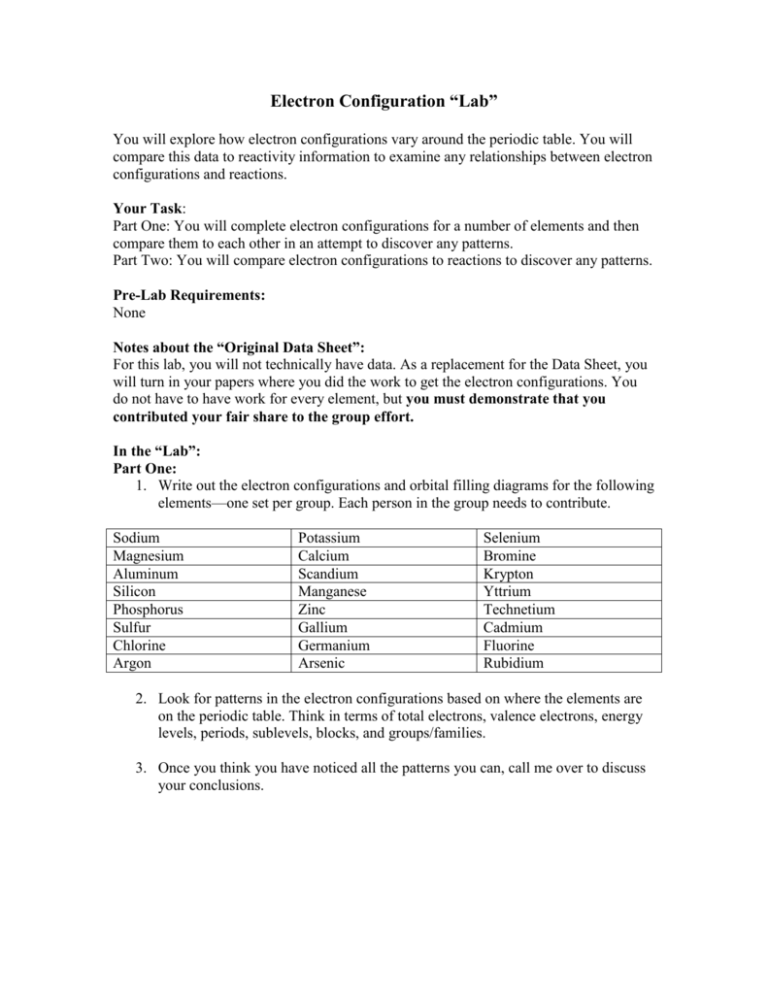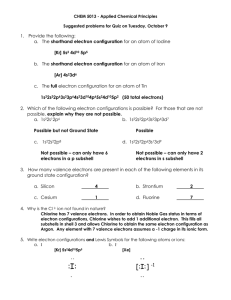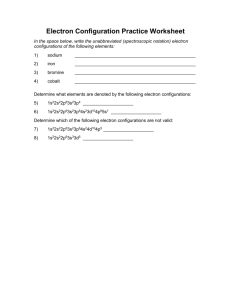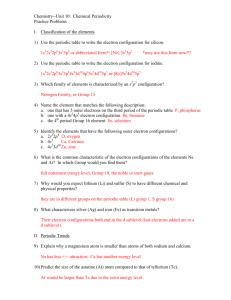Electron Configuration “Lab”
advertisement

Electron Configuration “Lab” You will explore how electron configurations vary around the periodic table. You will compare this data to reactivity information to examine any relationships between electron configurations and reactions. Your Task: Part One: You will complete electron configurations for a number of elements and then compare them to each other in an attempt to discover any patterns. Part Two: You will compare electron configurations to reactions to discover any patterns. Pre-Lab Requirements: None Notes about the “Original Data Sheet”: For this lab, you will not technically have data. As a replacement for the Data Sheet, you will turn in your papers where you did the work to get the electron configurations. You do not have to have work for every element, but you must demonstrate that you contributed your fair share to the group effort. In the “Lab”: Part One: 1. Write out the electron configurations and orbital filling diagrams for the following elements—one set per group. Each person in the group needs to contribute. Sodium Magnesium Aluminum Silicon Phosphorus Sulfur Chlorine Argon Potassium Calcium Scandium Manganese Zinc Gallium Germanium Arsenic Selenium Bromine Krypton Yttrium Technetium Cadmium Fluorine Rubidium 2. Look for patterns in the electron configurations based on where the elements are on the periodic table. Think in terms of total electrons, valence electrons, energy levels, periods, sublevels, blocks, and groups/families. 3. Once you think you have noticed all the patterns you can, call me over to discuss your conclusions. Part Two: 1. Compare your electron configurations with the following reference material on the reactions of the elements. Na – Very easily loses one electron Mg – Easily loses two electrons Al – Loses three electrons with effort Si – Can gain or lose four electrons P – Gains three electrons with effort S – Easily gains two electrons Cl – Very easily gains one electron Ar – Does not react, gain, or lose. K – Very easily loses one electron Ca – Easily loses two electrons Ga – Loses three electrons with effort Ge – Can gain or lose four electrons As – Gains three electrons with effort Se – Easily gains two electrons Br – Easily gains one electron Kr – Rarely reacts. Doesn’t gain or lose. 2. Write the electron configuration for each of the elements listed under Part Two after they have undergone the reactions listed for them. For example, since sodium (Na) normally has 11 electrons, it will have 10 electrons once it loses one. You should then write the electron configuration for 10 electrons. For Si and Ge, write both electron configurations. 3. Look for patterns in the electron configurations from before the reactions and after the reactions. 4. Once you think you have noticed all the patterns you can, call me over to discuss your conclusions. Lab Report: A) Purpose (5%) B) Work for the electron configurations (30%) C) Analysis Questions (50%) 1) Explain all of patterns discovered in Part 1 such that you explain how to determine the electron configuration simply by looking at the periodic table. 2) Explain the connection between the patterns discovered in Part 1 and the historical reasons for grouping elements in families. 3) Explain the shape of the periodic table in terms of the patterns discovered in Part 1. 4) Based on Part 2, what electron configurations are the most stable configurations? 5) Explain the properties of the elements that have the stable configuration discovered in Part 2 without needing to lose or gain electrons. 6) The most common reaction pattern for transition elements (d block) is losing two electrons. What does this fact suggest about how these elements lose electrons? A few sample electron configurations may be useful to show what you are talking about. D) Conclusion (15%)







